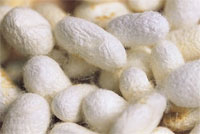|

Crops around the world: Moths, and more particularly their caterpillars, are a major agricultural
pest in many parts of the world. The caterpillar of the Gypsy moth
causes severe damage to forests in the North East USA, where it
is an exotic species. In temperate climates the Codling moth causes
extensive damage, especially to fruit farms. In tropical and subtropical
climates the diamondback moth is perhaps the most serious pest of
certain crops.
Serious munchers: Several moth species in the family Tineidae are commonly regarded
as pests because their larvae eat fabric such as clothes and blankets
made from natural fibers (like wool or silk.) They are less likely
to eat mixed materials containing artificial fibres. There are some
reports that they can be repelled by the scent of wood from juniper
and cedar, by lavender or by other natural oils. However,  many consider
this unlikely to prevent infestation. Naphthalene (the chemical
used in mothballs) is considered more effective, but there are concerns
over its effects on health. many consider
this unlikely to prevent infestation. Naphthalene (the chemical
used in mothballs) is considered more effective, but there are concerns
over its effects on health.
Silk creators : Some moths are farmed. Most notable is the silkworm (the larva
of the domesticated moth Bombyx mori), farmed for the silk with
which it builds its cocoon. The silk industry produces over 130
million kg of raw silk, worth about 250 million US dollars worldwide.
Not all silk is produced by Bombyx mori. There are several species
that are also farmed for their silk, such as the Ailanthus moth,
the Chinese Oak Silkmoth, the Assam Silkmoth and Japanese Silk Moth.

Follow the round light... Moths are apparently attracted to light, or more specifically, are
known to circle bright objects. The reason for this behaviour is
not known. It may be moths navigate by maintaining a constant angular
relationship to a bright celestial light (such as the moon), but
on encountering a bright artificial light it navigates by maintaining
a constant angle to the light, resulting in the moth flying in a
spiral until it hits the light source.
Night pollinators: Night-blooming flowers usually depend on moths (or bats) for pollination,
and artificial lighting can draw moths away from the flowers, affecting
the plant's ability to reproduce. For this reason, light pollution
is coming under increasing scrutiny as a source of many subtle ecological
changes.
All text is available under the terms
of the GNU Free Documentation License
|